|
Introduction
to the Rainforest
Life Cycle
Moth/butterfly
Specialist or
Generalist?
Food
Web/Trophic Cascade
Rainforest Ecology - Rainforest Products
|
|
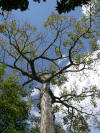
Guanacaste
tree at Nosara, Costa Rica, by Karen Retford
Introduction to the Rainforest
Objective: Students will learn basic information about the
rainforest. They will be able to identify and illustrate the different
levels of plant life in a rainforest and locate on a world map the location
of the world's rainforests.
Grade Level: 3rd - 8th
Prerequisite knowledge: Students must
be able to locate and read basic maps.
Standards:
California Science Standards 4th grade -
Life Science
3.0 Students know that living organisms
depend on one another for survival. As a basis for understanding this
concept:
- Students know that ecosystems can be
characterized by their living and non-living components.
- Students know that in a particular environment,
some kinds of plants and animals survive well, some survive less well,
and some cannot survive at all.
- Students know many plants depend on animals for
pollination and seed dispersal, and animals depend on plants for food and
shelter.
California History and Social Science
Standards 4th grade
4.1 Students demonstrate an understanding of the physical and human
geographic features that define places and regions in California.
- Explain and use the coordinate grid system of
latitude and longitude to determine the absolute locations of places in
California and on Earth.
- Distinguish between the North and South Poles;
the equator and the prime meridian; the tropics; and the hemispheres,
using coordinates to plot locations.
California English-Language Arts
Standards 4th grade
2.0 Students write compositions that
describe and explain familiar objects, events, and experiences. Student
writing demonstrates a command of standard American English and the drafting,
research, and organizational strategies.
2.4 Write summaries that contain main
ideas of the reading selection and the most significant details.
Materials:
Pictures of rainforests, a collection of
pictures or links to pictures and animals in the rainforest, drawing paper,
blank map of the world (1 for each student), unlabeled picture of rainforest
canopy (copies for each student, plus one overhead for teacher), rulers,
colored pencils, watercolors, lined paper, and paint brushes. Also: an overhead
or access to Power Point.
Time: 1 to 2 hours
Teacher Models:
Teacher introduces the rainforest.
The students are given the definition of the rainforest and shown on a world
map where rainforests are located. Students are then instructed on the
different layers of the rainforest either through Power Point or an overhead
illustrating the canopy layers. Below is a graphic representation of the
different layers of the rainforest. Used by permission
www.mongabay.com.
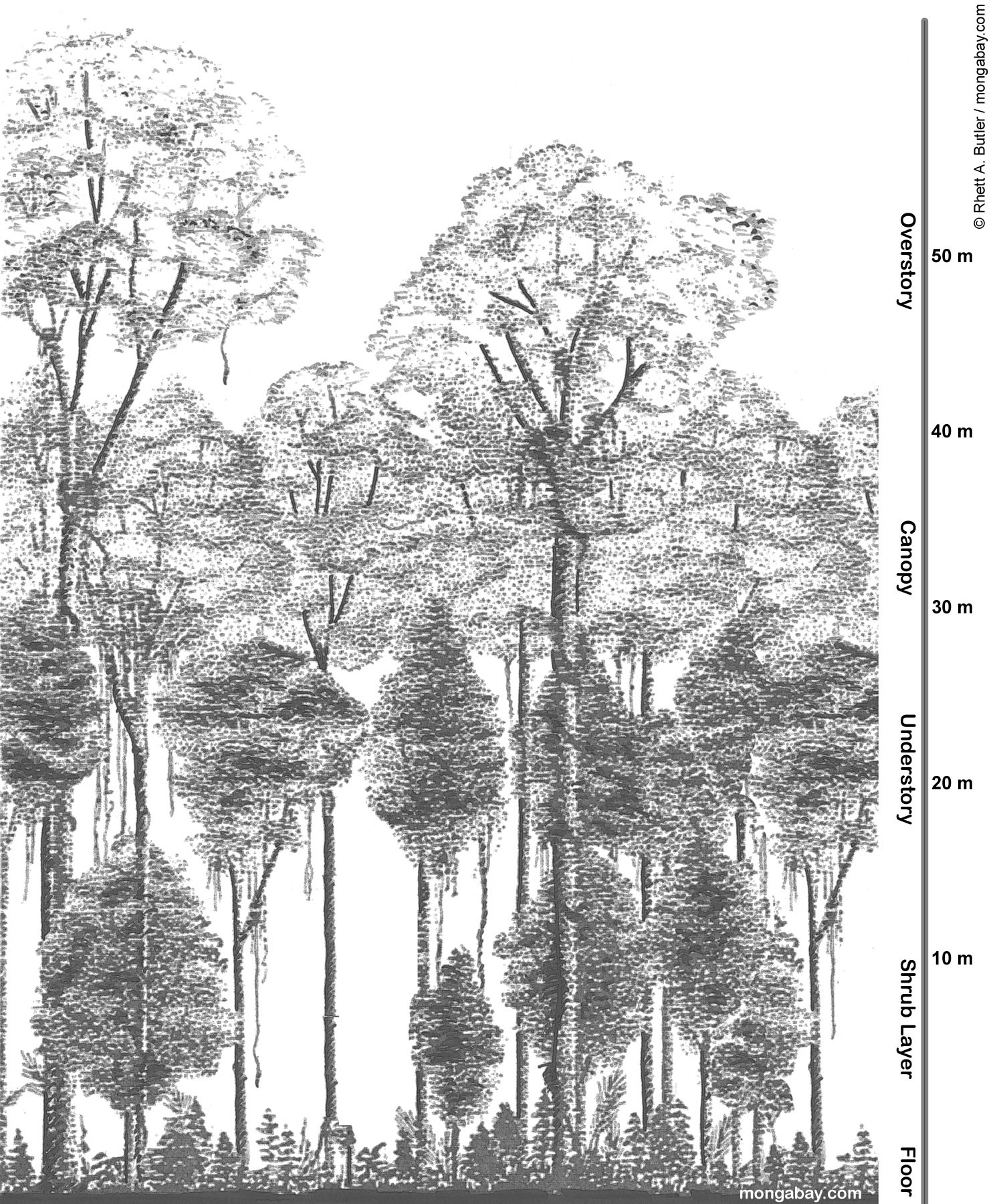
Following presentation the teacher will
lead the class in the composition of a paragraph summarizing the information
learned about a rainforest.
Guided Practice:
- Students are placed in groups of four.
- Students color a map showing where the
rainforests of the world are located. To label their unlabeled
copy of the rainforest layers.
- Students must be able to explain their choices
and give a brief presentation in the form of a complete paragraph.
- Teacher circulates and assists where needed.
- Students present their work.
Independent Practice:
- Each student must create an illustration of the
layers of the rainforest. The illustration must include labels for the
different levels and the heights of the plants at that level.
- Each student will create a map of the world
showing the location of the world's rainforests. The map shall
include labels for the equator, the Tropic of Cancer and the Tropic of
Capricorn.
- Students must complete a complete paragraph
describing a rainforest.

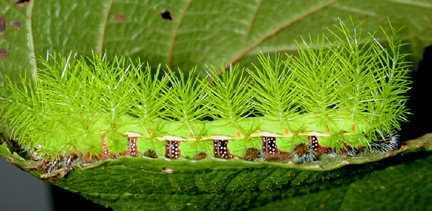
Saturniidae, Automeris brick red patches.
Dyer, L.A. and G.L. Gentry. 2002. Caterpillars and parasitoids of a tropical
lowland wet forest. http://www.caterpillars.org. Accessed: (June 27,2005).

Life Cycle of Butterflies and Moths
Objective:
Students will learn about the life cycle of
butterflies and moths. They will be able to define metamorphosis,
instar, caterpillar, pupa, and adult. Students will be able to
illustrate and label an illustration of the life cycle.
Grade Level: 3rd - 8th
Prerequisite Knowledge: this
lesson should precede the less on the food web/trophic cascade
Standards:
California Science Standards 4th grade -
Life Science
2. All organisms need energy and
matter to live and grow. As a basis for understanding this concept:
a. Students know plants are the
primary source of matter and energy entering most food chains.
b. Students know that producers and consumers
are related in food chains and food webs and may compete with each other for
resources in an ecosystem.
Materials:
Power point illustrating the different
stages of the lifecycle or a post with similar illustrations. Access to
internet. Bookmark: www.caterpillars.org
Time: 1 to 2
hours
Teacher Models:
Teacher teaches the lifecycle of the
butterfly or moth using the Power Point Life Cycle of the Butterfly or Moth Life
Cycle of the Butterfly or Moth
Guided Practice:
Students in groups of four illustrate a
life cycle of a butterfly or moth. The group needs to be prepared to
share their quick illustration with the class. Each member of the group
must contribute one illustration to the picture.
Independent Practice:
Students are to create their own
illustration of a butterfly/moth lifecycle. Students may utilize
pictures from the resources they’ve used in their research.

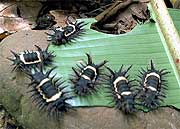
Dyer, L.A. and G.L. Gentry. 2002. Caterpillars
and parasitoids of a tropical lowland wet forest.
http://www.caterpillars.org. Accessed: (June 27,2005).

Specialist or Generalist: Who will Survive?
Objective:
Students will use the inquiry method to determine who has a greater chance of survival
if there is a change in the environment: a specialist or a generalist.
Grade Level: 3rd - 8th
Prerequisite Knowledge: Some background knowledge about caterpillars and
their lifecycle.
Standards:
California Science Standards 4th grade -
Life Science
3.Living organisms depend on one another
for survival. As a basis for understanding this concept:
- Students know ecosystems can be characterized
by their living and non living components.
- Students know that in a particular environment,
some kinds of plants and animals survive well, some survive less well,
and some cannot survive at all.
- Students know many plants depend on animals for
pollination and seed dispersal, and animals depend on plants for food
and shelter.
Materials:
Pictures or charts of specialist
caterpillars i.e. silk worm (mulberry), monarch caterpillar (milkweed),
California Dogface (false indigo), California Sister (leaves of oaks) etc.
and generalist caterpillars: i.e. Painted Lady, Eastern Tiger Swallowtail,
Luna Moth, etc. This website has information on caterpillar food: www.butterflywings.com/species.html
or butterfly identification cards at: http://www.reimangardens.iastate.edu/en/butterflies/butterfly_identification_cards.cfm
Time: 1 to 2 hours
Teacher Models:
There are two categories that caterpillars
can be put into, generalists and specialists. A generalist will eat a wide variety of plants
while a specialist will only eat one plant variety. An example of a
generalist is a Painted Lady. An example of a specialist is a Monarch
larvae; they only eat one kind of food- milkweed. Who do you
think is going to survive if there is a change in the habitat?
Situation: In the central valley
farmers are using herbicides to keep weeds out of their orchards. Herbicides
kill weeds and other plants if not used carefully. Milkweed,, in the
eyes of the farmer or gardener, is a weed, therefore they try to get rid of
it. Monarch larvae are designed to only eat milkthistle, if the
milkthistle is "weeded out" there is no food for the monarch
larvae. The Painted Lady can feast on 100 different host plants
thistles, hollyhock, mallow, and many legumes. So if one plant is
killed by herbicide it can find another that it likes. Currently the
habitat for Monarch's is dwindling, there aren't as many milkthistles as
there once were, resulting in less Monarchs.
Task: Create a poster illustrating
both a generalist and a specialist caterpillar. Include in the poster an
illustration of the larvae stage as well as the adult stage of the butterfly
and their food source.
Guided Practice:
Whole group pick out a generalist
caterpillar (West Coast Lady) and a specialist (Queen) and each student must
create an illustration as in the task above.
Independent Practice:
Student must select their own specialist
and generalist and create and illustration as in the task above.

Food Webs and
Trophic Cascades
Objective: Students will be able to describe the elements of a
food chain. They will then be able to describe and illustrate a trophic
cascade as a component of the food web.
Prerequisite Knowledge: Students know how to classify animals and
differentiate them from plants.
Standards:
California Science Standards 4th grade -
Life Science
2. All organisms need energy and
matter to live and grow. As a basis for understanding this concept:
- Students know plants are the primary source of
matter and energy entering most food chains.
- Students know producers and consumers
(herbivores, carnivores, omnivores, and decomposers) are related in food
chains and food webs and may compete with each other for resources in an
ecosystem.
- Students know decomposers including many fungi,
insects, and microorganisms, recycle matter from dead plants and
animals.
3.Living organisms depend on one another
for survival. As a basis for understanding this concept:
- Students know ecosystems can be characterized
by their living and non living components.
- Students know that in a particular environment,
some kinds of plants and animals survive well, some survive less well,
and some cannot survive at all.
- Students know many plants depend on animals for
pollination and seed dispersal, and animals depend on plants for food
and shelter.
Materials: Power Point or posters illustrating food webs and
trophic cascades. Drawing paper, access to the internet, glue, and
scissors.
Time:1 to 2 class periods
Teacher Models:
Teacher discusses the interdependence of
animals involved in a food web. This discussion can be specific to a
particular biome such as the rainforest, tundra, etc. Using Power Point
or Posters illustrate some food webs including the following terms:
Producers, consumers, decomposers, energy source, herbivores, carnivores, and
omnivores.
Introduce the term tropic cascade.
This is a system where a predator causes a change in the plant biomass by
controlling the herbivore population. In other words a predator,
affects an herbivore, which affects the plant biomass. An example would
be a mountain lion eating deer, the less deer the more plant biomass, more
deer more plant biomass.
Below are two illustrations of food webs.
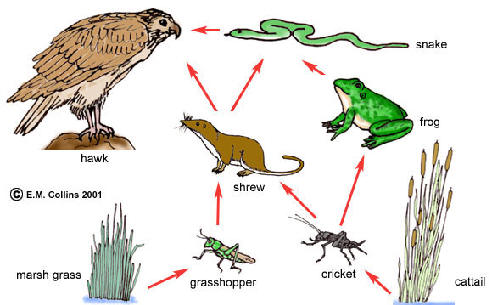
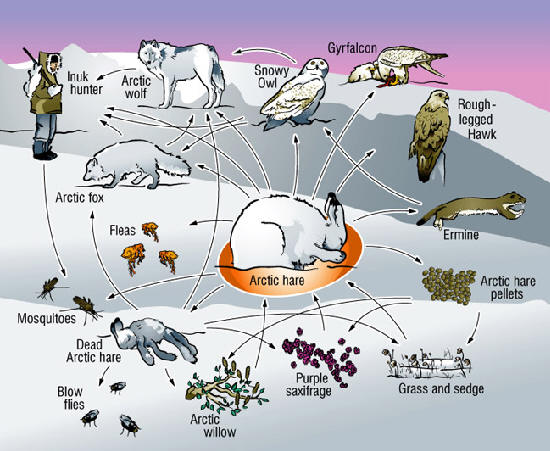
Guided Practice:
With teacher acting as a secretary the
students create a food web. Teacher can illustrate on the board or on
an overhead. Encourage students to explain their choices and if there
are errors help to clarify. Encourage students to come up with trophic
cascades.
Independent Practice:
Students create a food web with a
trophic cascade. They need to illustrate and write a paragraph
describing their web.


Rainforest Ecology – Rainforest Products
Objectives:
Students will be able to describe the
use and origin of a product that has its origin in the tropical or
subtropical rainforest.
Prerequisite Knowledge:
Students must have knowledge of the
geographical location of tropical and subtropical rainforests. Online
research skills and the ability to gather information from a variety of
sources. Students must have a working knowledge of the writing domains
for the given grade level.
Standards
This lesson is written using the
California Standards for 4th grade it can easily be adapted up or down the
grade spans.
Life Sciences
- All organisms need
energy and matter to live and grow. As a basis for understanding this
concept:
- Students know plants
are the primary source of matter and energy entering most food chains.
- Students know producers
and consumers (herbivores, carnivores, omnivores, and decomposers) are
related in food chains and food webs and may compete with each other
for resources in an ecosystem.
- Students know decomposers,
including many fungi, insects, and microorganisms, recycle matter from
dead plants and animals.
- Living organisms
depend on one another and on their environment for survival. As a basis
for understanding this concept:
- Students know
ecosystems can be characterized by their living and nonliving
components.
- Students know
that in any particular environment, some kinds of plants and animals
survive well, some survive less well, and some cannot survive at all.
- Students know
many plants depend on animals for pollination and seed dispersal, and
animals depend on plants for food and shelter.
- Students know that
most microorganisms do not cause disease and that many are beneficial.
Language Arts
Reading
1.0 Word Analysis,
Fluency, and Systematic Vocabulary Development
Students understand the basic features of reading. They select letter
patterns and know how to translate them into spoken language by using
phonics, syllabication, and word parts. They apply this knowledge to achieve
fluent oral and silent reading.
Word Recognition
1.1 Read narrative and expository text aloud with grade-appropriate fluency
and accuracy and with appropriate pacing, intonation, and expression.
Vocabulary and Concept Development
1.2 Apply knowledge of word origins, derivations, synonyms, antonyms, and
idioms to determine the meaning of words and phrases.
1.3 Use knowledge of root words to determine the meaning of unknown words
within a passage.
1.4 Know common roots and affixes derived from Greek and Latin and use this
knowledge to analyze the meaning of complex words (e.g., international).
1.5 Use a thesaurus to determine related words and concepts.
1.6 Distinguish and interpret words with multiple meanings.
2.0 Reading
Comprehension
Students read and understand grade-level-appropriate material. They draw
upon a variety of comprehension strategies as needed (e.g., generating and
responding to essential questions, making predictions, comparing information
from several sources). The selections in Recommended Literature,
Kindergarten Through Grade Twelve illustrate the quality and complexity
of the materials to be read by students. In addition to their regular school
reading, students read one-half million words annually, including a good representation
of grade-level-appropriate narrative and expository text (e.g., classic and
contemporary literature, magazines, newspapers, online information).
Structural Features of Informational Materials
2.1 Identify structural patterns found in informational text (e.g., compare
and contrast, cause and effect, sequential or chronological order,
proposition and support) to strengthen comprehension.
Comprehension and Analysis of Grade-Level-Appropriate Text
2.2 Use appropriate strategies when reading for different purposes (e.g.,
full comprehension, location of information, personal enjoyment).
2.3 Make and confirm predictions about text by using prior knowledge and
ideas presented in the text itself, including illustrations, titles, topic
sentences, important words, and foreshadowing clues.
2.4 Evaluate new information and hypotheses by testing them against known
information and ideas.
2.5 Compare and contrast information on the same topic after reading several
passages or articles.
2.6 Distinguish between cause and effect and between fact and opinion in
expository text.
2.7 Follow multiple-step instructions in a basic technical manual (e.g., how
to use computer commands or video games).
3.0 Literary
Response and Analysis
Students read and respond to a wide variety of significant works of
children's literature. They distinguish between the structural features of
the text and the literary terms or elements (e.g., theme, plot, setting,
characters). The selections in Recommended Literature, Kindergarten
Through Grade Twelve illustrate the quality and complexity of the
materials to be read by students.
Structural Features of Literature
3.1 Describe the structural differences of various imaginative forms of
literature, including fantasies, fables, myths, legends, and fairy tales.
Narrative Analysis of Grade-Level-Appropriate Text
3.2 Identify the main events of the plot, their causes, and the influence of
each event on future actions.
3.3 Use knowledge of the situation and setting and of a character's traits
and motivations to determine the causes for that character's actions.
3.4 Compare and contrast tales from different cultures by tracing the
exploits of one character type and develop theories to account for similar
tales in diverse cultures (e.g., trickster tales).
3.5 Define figurative language (e.g., simile, metaphor, hyperbole,
personification) and identify its use in literary works.
Writing
1.0 Writing
Strategies
Students write clear, coherent sentences and paragraphs that develop a
central idea. Their writing shows they consider the audience and purpose.
Students progress through the stages of the writing process (e.g.,
prewriting, drafting, revising, editing successive versions).
Organization and Focus
1.1 Select a focus, an organizational structure, and a point of view based
upon purpose, audience, length, and format requirements.
1.2 Create multiple-paragraph compositions:
- Provide an
introductory paragraph.
- Establish and support
a central idea with a topic sentence at or near the beginning of the first
paragraph.
- Include supporting
paragraphs with simple facts, details, and explanations.
- Conclude with a
paragraph that summarizes the points.
- Use correct
indention.
Research and Technology
1.5 Quote or paraphrase information sources, citing them appropriately.
1.6 Locate information in reference texts by using organizational features
(e.g., prefaces, appendixes).
1.7 Use various reference materials (e.g., dictionary, thesaurus, card
catalog, encyclopedia, online information) as an aid to writing.
1.8 Understand the organization of almanacs, newspapers, and periodicals and
how to use those print materials.
1.9 Demonstrate basic keyboarding skills and familiarity with computer
terminology (e.g., cursor, software, memory, disk drive, hard drive).
Evaluation and Revision
1.10 Edit and revise selected drafts to improve coherence and progression by
adding, deleting, consolidating, and rearranging text.
2.0 Writing
Applications (Genres and Their Characteristics)
Students write compositions that describe and explain familiar objects,
events, and experiences. Student writing demonstrates a command of standard
American English and the drafting, research, and organizational strategies
outlined in Writing Standard 1.0.
2.3 Write information reports:
- Frame a central
question about an issue or situation.
- Include facts and
details for focus.
- Draw from more than
one source of information (e.g., speakers, books, newspapers, other
media sources).
2.4 Write summaries that contain the main ideas of the reading selection
and the most significant details.
History and Social Studies
4.1 Students
demonstrate an understanding of the physical and human geographic features
that define places and regions in California.
- Explain and use the
coordinate grid system of latitude and longitude to determine the
absolute locations of places in California and on Earth.
- Distinguish between
the North and South Poles; the equator and the prime meridian; the
tropics; and the hemispheres, using coordinates to plot locations
4.2 Students describe
the social, political, cultural, and economic life and interactions among
people of California from the pre-Columbian societies to the Spanish mission
and Mexican rancho periods.
- Discuss the major
nations of California Indians, including their geographic distribution,
economic activities, legends, and religious beliefs; and describe how
they depended on, adapted to, and modified the physical environment by
cultivation of land and use of sea resources.
- Identify the early
land and sea routes to, and European settlements in, California with a
focus on the exploration of the North Pacific (e.g., by Captain James
Cook, Vitus Bering, Juan Cabrillo), noting especially the importance of
mountains, deserts, ocean currents, and wind patterns.
- Describe the Spanish
exploration and colonization of California, including the relationships
among soldiers, missionaries, and Indians (e.g., Juan Crespi, Junipero
Serra, Gaspar de Portola).
Materials:
Internet Access, student world maps (8
for 8 groups), pictures of products from the tropical and subtropical
rainforest (9 sets, 8 for students 1 for instructor),
Time:
2 weeks for entire lesson
Anticipatory Set:
Have you ever wondered where the food we
eat comes from? Each group has a map of the world and a set of labeled
pictures of plants. As a group I want you to put the picture of the plant
where you think it originated (came from originally) in the world. Be
prepared as a group to tell why you think it came from that part of the world.
Allow students about 15 minutes to place the plants on their map and to
develop a theory or explanation to support their choice. Using pictures
and information from Plant Origins.htm for
pictures and origin there are links provided for research later.
Groups present their ideas.
Then the teacher uses a world map and
the same set of pictures and lets the students know where the plants
originate. After placing and explaining ask the students if they see a
pattern. All of the plants come from either tropical or subtropical
areas.
Teacher Models:
Nearly 80% of what we eat today
originates in tropical and subtropical areas. Plants adapt to their
environments and so certain plants are only found in certain climates. Review
the Tropic of Cancer, the Tropic of Capricorn, and the Equator. We are
going to research plants or foods that originally came from the
tropics. Then we will use internet and library resources to write a
report of information about our chosen plant. Teacher chooses one
of the plants from the Plant Origins.htm
and the links provided to illustrate how to do the research. Teacher
models connecting to the link, reading the information, taking notes, and
creating a report of information. Using the overhead show on a world
map the location of the plants origin.
Guided Practice:
Students and teacher choose another
plant from Plant Orgins.htm and the teacher
assists the students in researching, taking notes, and creating a report of
information, indicate the origin of the plant on a map.
Independent Practice:
Students choose a plant from Plant Origins.htm and research, take notes,
and create a report of information. Students may also include an illustration
with their research and include a map showing the origin of the plant.
|




